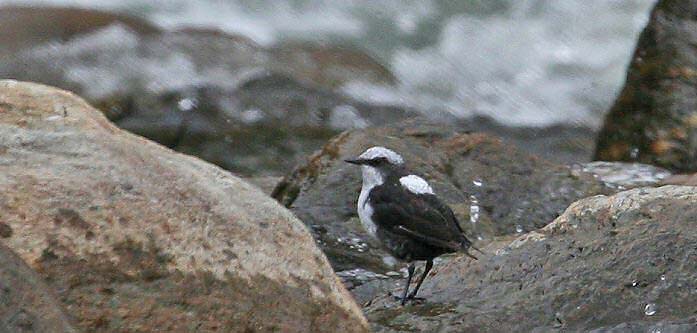
a web page by Don Roberson |
DIPPERS Cinclidae |
|
 |
John Muir, the great American environmentalist of the 19th century who so loved to hike in the Sierra Nevada, wrote that the Dipper, "among all the mountain birds, none has cheered me so much in my lonely wandering" (Muir 1878). Twenty years later he wrote again of the dipper: "Bird and stream are inseparable, songful and wild, gentle and strong, the bird ever in danger in the midst of the stream's mad whirlpools, yet seemingly immortal. And so I might go on, writing words, words, words: but to what purpose? Go see him and love him, and through him as through a window look into nature's warm heart" (Muir 1898). The late David Gaines, a great American environmentalist of the 20th century, used Muir's words as his afterward in the classic Birds of Yosemite and the East Slope (Gaines 1988). The dippers do stir human souls as they go about their ordinary lives. |
The entire life-cycle of all the dippers is tied to their specialized habitat. Nest are often built behind waterfalls, or under bridges. Recently fledged young, like this fledgling American Dipper (left), quickly take to their watery home, following parents around by hopping from rock to rock, or chasing them on short, fast-moving wings. There is just one dipper — American Dipper — in North America, with a range stretching from Alaska, through the western United States, and south in the mountains to Panama. Its colloquial name throughout western North America is "Water Ouzel." |
Of the European bird, White-throated Dipper, Witherby (1943) wrote that it "delights to perch on stone or rock protruding from water, bobbing and curtseying in characteristic fashion as if hinged on legs, with accompanying downward jerk of tail and blinking of white eye-lid." Again, this can be said of any dipper. Pairs tend to be mated for long periods, even year after year in some locales. A dipper's song is a loud, musical, bubbling and wren-like affair. Some species, like White-throated Dipper, may sing throughout much of the year, including to establish winter territories. In some populations of dippers, though, males may be polygynous, helping to rear the broods of two, three, or even four females (Ormerod & Tyler 2005). |
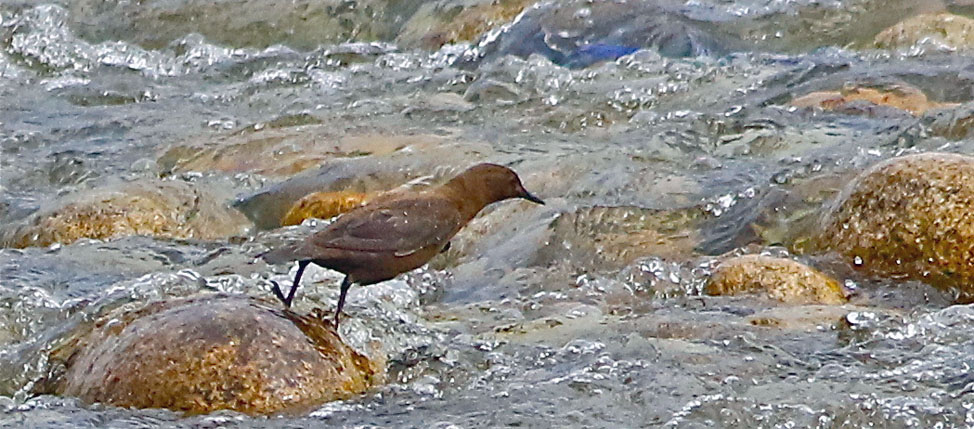 |
"Dippers are extraordinary in being the only passerines adapted to exploit aquatic habitats fully, by swimming and diving. ... Dippers have many of the physiological adaptations for diving that are possessed by other aquatic birds. For example, there is an immediate drop in the heart rate as a bird plunges under water, and a further decline during the period of submersion. As the dipper surfaces, the heart rate increases. Dipper blood has a higher concentration of haemoglobin than that found in comparable passerines, allowing for greater oxygen storage;" Ormerod & Tyler (2005). Dippers pursue a large variety of underwater prey, including small fish, dragonfly or caddis-fly larvae, and a rich diversity of aquatic invertebrates.
Yet, dippers have good eyesight underwater. This American Dipper (below) in juvenal plumage (note narrow buffy edges to upperwing coverts and tertial) is peering underwater. Dippers are generally restricted to their mountain streams, but this particularly young bird was a vagrant to a coastal park with a very small stream in Monterey, California, during winter 2012-13. |
 |
South America also has two species. The White-capped Dipper (right, photo by William Hull) is a bird of Andean streams from Venezuela to Bolivia. Rufous-throated Dipper Cinclus schulzi is very locally distributed in the eastern Andes of s. Bolivia and nw. Argentina. |
Photos: The nesting American Dipper Cinclus mexicanus, shown in three photos amidst a waterfall, was in Sierra Co., California, on 20 June 2014. The fledgling American Dipper was along the Carmel River below San Clemente Dam, Monterey Co., California, in May 1987, and the vagrant juvenal peering underwater was at Laguna Grande Park, Monterey Co., California, on 4 Jan 2013. The White-throated Dipper C. cinclus was at Huzu Bei Shan, Qinghai Province, China, in June 2004. The Brown Dipper C. pallasii was at Jakar, Bhutan, on 26 Mar 2019. William Hull photographed the White-capped Dipper C. leucocephalus at Lodge, Ecuador.
Bibliographic note: There is family book in the Poyser series but I have not seen it: Tyler, S.J., & Ormerod, S.J. 1994. The Dippers. T. & A.D. Poyser, Calton, U.K. David Suddjian has kindly supplied this capsule review:
Such a book may indeed bring together important research, but the focus on a single species with an "afterthought" to the other species in the family probably does not qualify as a true "family book" in the traditional sense. Fortunately, the authors of the Poyser book are also the authors of the Handbook of the Birds of the World chapter: Ormerod & Tyler (2005). Thus their prior research is now incorporated in a true "family" text, and now gilded with some dazzling photos. Literature cited:
|
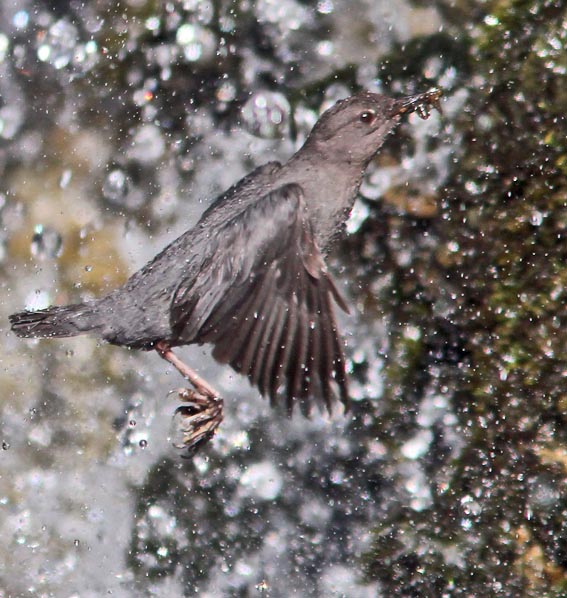 The Dippers are five closely related species that share a distinctive lifestyle. Of the American Dipper (right and above), Hoffman (1927) wrote that it "is an astonishing sight to see a bird ... dive headlong into a foaming mountain stream and disappear under its waters. ... The dipper has adopted the water as its element and lives its whole life over and in the pools and waterfalls of brooks and rivers." This can be said of any dipper. This adult has built a nest behind a waterfall, and flies through the cascade with each delivery of food to the young.
The Dippers are five closely related species that share a distinctive lifestyle. Of the American Dipper (right and above), Hoffman (1927) wrote that it "is an astonishing sight to see a bird ... dive headlong into a foaming mountain stream and disappear under its waters. ... The dipper has adopted the water as its element and lives its whole life over and in the pools and waterfalls of brooks and rivers." This can be said of any dipper. This adult has built a nest behind a waterfall, and flies through the cascade with each delivery of food to the young. 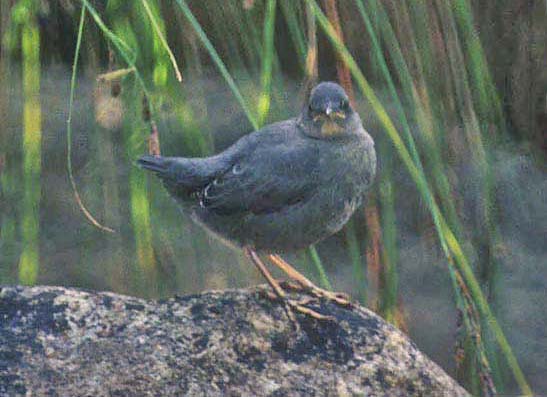
 Eurasia has two dippers: White-throated Dipper from Britain across the Palearctic to China (left, a photo from China), and Brown Dipper along swift rivers in the Himalayas (below, a photo from Bhutan).
Eurasia has two dippers: White-throated Dipper from Britain across the Palearctic to China (left, a photo from China), and Brown Dipper along swift rivers in the Himalayas (below, a photo from Bhutan). 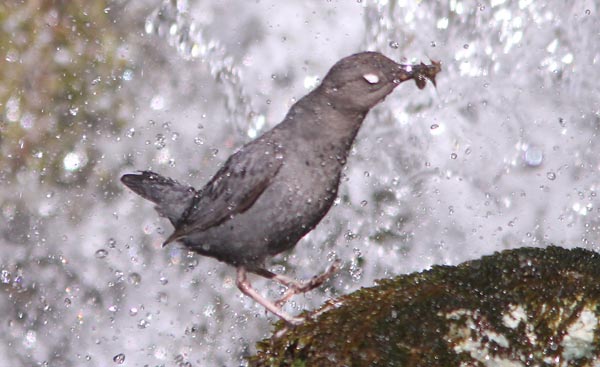 Dippers have a white eye-lid that protects the eye, including in the pounding waters of a cascade. This is apparent in this shot of the Sierra Nevada bird near the nest (left; same individual as top of the page).
Dippers have a white eye-lid that protects the eye, including in the pounding waters of a cascade. This is apparent in this shot of the Sierra Nevada bird near the nest (left; same individual as top of the page). 